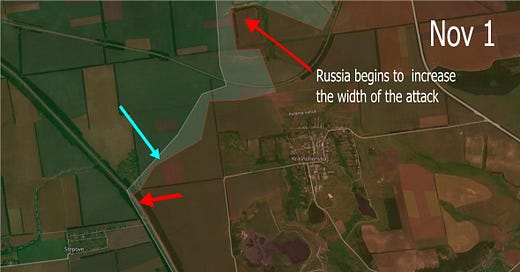Hello everbody!
Today, Donald Hill is continuing his review of the Battle for Stepove, on the northern flank of the Avdiivka sector - a campaign seeing the most fierce, most sustained Russian offensive operations since the Battle of Bakhmut, early this year.
This is a continuation from the Part 1, posted yesterday…
***
Perhaps as soon as one day after the Ukrainians were forced to withdraw from their positions southwest of Krasnohorivka, they were forced to withdraw from the slagheap too. Sure, all the Russian efforts to overrun the slagheap were costly failures: the Russians suffered extensive casualties to the Ukrainian artillery fire and drones. They also experienced massive problems with targeting Ukrainian positions dug in the eastern and western sides of the slagheap. However, gradually, the constant Russian drone attacks demolished defensive positions and the interdiction of the road leading to the top of the slagheap made it too dangerous to remain there and try holding any longer. The first two drone bombs show attacks on Russian positions on top of the slagheap:
https://twitter.com/NOELreports/status/1725165741790355971
Russia was now engaging Ukraine over 2.5 km of the railroad treeline and their constant waves of attacks allowed them to gain control over the eastern wood-line that parallels the railroad. Ukraine would launch counterattacks and drive them out, but then then another three- or four waves of Russians would force the Ukrainians back, sometimes because they ran out of ammunition. At least one such counterattack by Ukrainians ended in a costly failure.
Sometimes the two sides would fire at each other across the railroad just 50-70 meters apart from each other. If the involved Ukrainian units received ammunition and reinforcements in time then they would generally be able to hold. But in order to reach their fellow soldiers, Ukrainian vehicles and soldiers would have to cross open fields that were constantly attacked by Russian artillery and drones. If Russian drones were overhead, the artillery and mortar fire was incessant, and: cold fact is that the drones were almost always overhead. The only way Ukrainian troops could survive was by them hunkering in their deep trenches, and even then survival was a matter of chance:
https://twitter.com/FundPerun/status/1725121353307590958
Both Ukraine and Russia had drones on the air but Russia had a lot more of them, and the types they are deploying nowadays are much better than a year ago: foremost, nowadays they are capable in operating in moist weather and very low temperatures.
Generally, the modern-day deployment of the Russian UAVs is comparable to an onion: there are three ‘layers’.
Slightly bigger UAVs, like Orlans, are nowadays flying relatively high (up to 2,000m), are used to monitor the battlefield from the distance, reconnoiter Ukrainian defensive positions, emit electronic countermeasures, monitor and record the activity of Ukrainian electronic systems, and serve as relays. Smaller drones are flying closer to the Ukrainians, and spot for artillery. Finally, FPVs are used for attack purposes: some are deployed to attack field fortifications, others roam deeper behind the frontlines and are targeting Ukrainian vehicles - both moving to the front lines and those few kilometres behind it. Tanks, APCs and trucks bringing supplies and evacuating the wounded were hit. Infantry in the trenches were attacked with artillery and mortars.
Cold fact is: the Russians are nowadays capable of excellently coordinating these three types of drones. At least in the Avidiivka sector - and exactly as feared by leaders of the Ukrainian ‘Army of Drones effort’, already 8-9 months ago - they are in possession of clear superiority in this field. Ukrainian efforts to destroy or at least suppress the Russian drones were sometimes successful but each attempt usually resulted in attracting yet more of artillery attacks.
Russia kept attacking across the railroad for a week without making progress. Sometimes they would take a section of the western side of the railroad only to get hit by all arms at Ukrainian disposal, suffer heavy losses and then be pushed back. Sometimes Ukrainians would kick the Russians out of a section on the eastern side too - only to be forced to fall back.
The Control of the eastern side of the railroad also gave the Russians some protection for the constant flow of troops traveling across the fields to reach the eastern side. Ukrainians became unable to target them with direct fire from the ground, although their drones were still able to call indirect fire on the columns or groups of troops. Here’s a video of a Russian column getting hit with artillery.
As obvious, the Russians moved in a column, because of the mines. If the path is safe for the first vehicle then it is safe for all the vehicles following behind it. When artillery knocks out one vehicle those behind have to move around it, off the path and thus regularly run over another mine…
This is another video that shows not only the Russian casualties but the density of the mines. When a vehicle detonates a mine it creates a pathway. To fill that pathway both sides use artillery to deploy mines. Sometimes the soldiers or robot vehicles will replace the mines, too:
https://twitter.com/GloOouD/status/1723603640869343250
The fighting reached such ferocity, that - rather unusually for this war - both sides began deploying tanks and infantry fighting vehicles in direct fire-support role, despite the ever-present threat of enemy FPVs and artillery. Especially US-supplied M2/M3 Bradleys have proved effective in providing their infantry with fire-support, with their 25mm auto-canons, like this one:
https://twitter.com/John20230/status/1721482469269029134
However, the Russian and Ukrainian drones are, literally, everywhere. In two days, Ukraine lost three Bradleys and a Leopard to drones. Another Bradley was immobilized by a mine:
https://twitter.com/squatsons/status/1721955788934242648
(…to be continued in the Part 3…)





Thanks for that excellent “series”. It make me able to follow correctly the sometimes confused info coming from other sources (but, why anyone may look for other sources having here the tandem Tom-Don?)